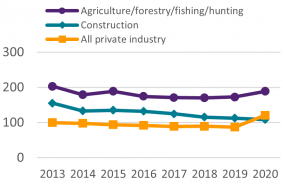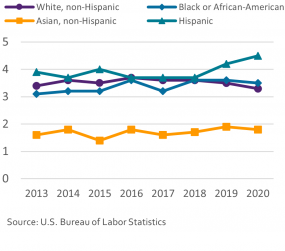Occupational Health Equity Program
Not all workers have the same risk of work-related health problems, even when they have the same job. Factors that place some workers at greater risk include exclusion and discrimination based on demographics, economic trends, and organizational factors. The Occupational Health Equity Program:
- Promotes research to identify, understand, and eliminate occupational health inequities closely linked with social, economic, and environmental disadvantage.
- Integrates inclusive research practices to reflect societal diversity and account for differing experiences of social conditions.
- Improves understanding of how work as a social determinant of health contributes to the inequitable distribution of illness, injury, mortality, and well-being.
- Improve data collection to better capture differences in the number and type of injuries, illnesses, and fatalities among underserved workers.
- Better understand how economic costs like days away from work and healthcare expenses vary across populations.
- Expand collaborations with researchers within and outside of NIOSH.
- Study injuries and chronic diseases by including occupational health questions in ongoing studies.
- Design and evaluate interventions aimed at eliminating occupational health inequities in partnership with community-based organizations and others.
- Partner with state and federal agencies interested in worker safety and health, including city and state health departments and other CDC programs, to share information and helpful tools to protect more workers.
- Recommended a shift from a biomedical to biopsychosocial paradigm, which explores the interactions between biology, psychology, and social contexts. This new paradigm will help further our understanding of social determinants of health and advance health equity.
- Provided technical assistance for the Centro de los Derecho del Migrante’s Protein Processing Project.
- Established a Sexual and Gender Minority Equity work group at NIOSH to advance research in this area.
- Published studies examining health inequities:
- Sociopolitical values and social institutions: Studying work and health equity through the lens of political economy
- Poor-quality employment and health: How a welfare regime typology with a gender lens illuminates a different work-health relationship for men and women
- Healthcare access among essential critical infrastructure workers, 31 states, 2017 ‒ 2018
- Cumulative risks from stressor exposures and personal risk factors in the workplace: Examples from a scoping review
- Publish a strategic plan on safety and health research priorities for American Indian and Alaska Native communities. This follows a CDC Tribal Consultation to get input from tribal leaders.
- Examine risk factors, including social determinants of health, for COVID-19 among diverse seafood workers in the Gulf of Mexico.
- Examine the well-being and vaccine perspectives among the multilingual and diverse meat processing workforce during the COVID-19 pandemic.
- Translate NIOSH’s “Protéjase en el Trabajo” (protect yourself at work) educational materials, including brochures and posters, into English for adult English-language learners.

Mention of any company or product does not constitute endorsement by the National Institute for Occupational Safety and Health, Centers for Disease Control and Prevention
The Occupational Health Equity Program seeks to eliminate avoidable work-related injury, illness, and death that are closely linked with social, economic, or environmental disadvantage. This snapshot shows recent accomplishments and upcoming work.

Source: U.S. Bureau of Labor Statistics

Source: U.S. Bureau of Labor Statistics
To learn more, visit
https://www.cdc.gov/niosh/programs/ohe/default.html
September 2022
